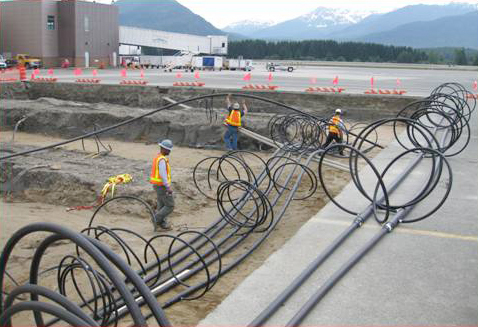
Rising fuel prices have long put builders on the lookout for a viable alternative to expensive boilers with low efficiency.
In Juneau, the answer has come in the form of heat pumps.
The new facility would replace the library that’s been renting space in the Mendenhall Mall for more than 25 years.
If awarded, the grant would provide more than one million dollars of the estimated $1.3 5 million needed for installing the heat pump.
The proposed library heat pump would be one of several in Juneau.
Three are already in operation and another three are under construction.
As CBJ Engineering Director Rorie Watt explains it, ground source heat pumps use tubing deep in the ground to bring heat to the surface.
[quote]“We pump liquid down these wells some hundreds of feet into the earth where the water is maybe 45 degrees or something. And we take a little bit of heat out of cold water and bring it back up the surface and run it through heat exchangers and turn that into useful heat in the facilities.”[/quote]
The growing number of heat pumps in use is a reflection of the advancement of the technology, Juneau’s geothermal resources and the opportunity for fuel savings.

Alaska Electric Light & Power installed the first Juneau heat pump in the late 1990s. Now the company has 21 heat pumps in its building in Lemon Creek.
Alec Mesdag is the Energy Management Specialist for AEL&P. Mesdag estimates heat pumps will save the company 50,000 dollars over 25 years.
The Dimond Park Aquatic Center and Juneau International Airport installed ground source heat pumps in 2010.
The airport terminal added approximately 12,000 square feet during the construction project. Roughly half the building is heated by 31 pumps.
Consulting engineer Doug Murray calls the savings so far “pretty incredible.”
[quote] “We were able to put some preliminary information together for the first years’ worth of operation this last May or June. That was showing approximately a $120,000 worth of savings in the first year.[/quote]In October, Juneau voters approved a bond issue which will provide another 6.9 million dollars to the airport. Some of the funds will be spent on more heat pumps, an expensive technology upfront.
Rorie Watt estimates the increase in construction costs to be as much as 50 percent.
[quote]“At the Auke Bay School, we estimated conventional oil system about $2.8 million and ground source heat a little over $4 million. So it’s a lot more capital intensive. But on the other hand we estimated that the energy costs would be about a third. So when you do ground source you’re essentially paying a lot more money upfront in exchange for lower long-term operating costs.”[/quote]AEL&P’s Mesdag says that long-term savings are the main reason ground source heat pumps are becoming more common in large projects, especially public buildings.
[quote] “ They’re built with the intention of being around for in the order of 50 or a hundred years. When we spend public money on a building ideally the plan should be for the long term because it’s expensive. With that being the case if you look at the lifecycle costs of that project, the longer it is in place, the more important the energy systems are to the overall lifecycle costs of the building. And when you look in the order of 50 years on a ground source heat pump, based on everything we know right now, that does make a lot of sense over the long term.” [/quote]
For more information check out these documents:
Airport Project Report: A Brief Report to the Alaska Energy Authority
Dimond Park Public Library Presentation
Study: Ground Source Heat Pumps in Cold Climates

Leave a Reply
You must be logged in to post a comment.